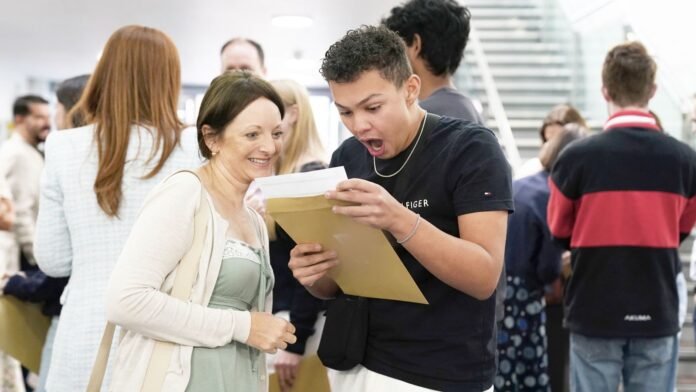Hundreds of thousands of teenagers who moved from primary to secondary school during the pandemic have received their GCSE results – with the gender gap for top grades persisting.
Nearly a quarter (24.5%) of girls achieved at least a grade 7 (A) compared to almost a fifth of boys (19.4%) – a 5.1 percentage point gap.
However, this is the closest the gap has been since 2000, when the earliest archive data is available.
It comes as 70.5% of girls were awarded at least a grade 4 (C) compared to 64.3% of boys – a 6.2 percentage point gap.
Cath Jadhav, vice president and responsible officer at GCSE providers Pearson, said the organisation views the gender gap as stable over the past few years and the decrease this time is fractions of a percentage point.
She said: “We don’t know the reasons for why that gap is narrowing… There will be lots of individual factors which affect that”
GCSEs used to be graded with a letter-based system but it began switching to a numbers-based system in 2017 – with 9 the highest and 1 the lowest.
Total number of total grades slightly up
Overall, more than a fifth (21.9%) of UK teenagers who received their GCSE results were awarded a grade 7 (A) this summer.
The figure is a 0.1% percentage point increase compared to last year.
However, the number of teenagers who achieved what is considered to be a “standard pass” is down on last year – with 67.4% of entries getting at least a 4 (C) grade compared to 67.6% in 2024.
The exam results received by students in England, Wales and Northern Ireland today will help them progress to sixth form, college or training.
Regional drops in GCSE standard pass rate
London has the highest percentage of teenagers (71.6%) achieving a standard pass for any region in England – but the figure is down nearly a full percentage point from 72.5% in 2024.
Most regions of the UK have seen a drop in the standard pass rate this year, though in many cases it is by a tiny margin.
For example, in the West Midlands the figure has fallen from 63.1% to 62.9%, the lowest for any region in England, while neighbouring East Midlands is down by just 0.1 percentage points from 65.1% to 65.0%.
GCSE data related to ethnicity or income measures, such as the grades achieved by people on free school meals, is not yet available but is due to be published in the coming months.
However, today’s data does show wide regional disparities in top GCSE grades.
The county with the highest percentage of top grades was Rutland in the East Midlands at 31.7%, while the Isle of Wight was the lowest performing ceremonial county, with just 12.9% of their students receiving 7 (A) or above, for the second year in a row.
Sir Ian Bauckham, chief regulator at Ofqual, England’s exams regulator, said: “The standard of work required to achieve a grade seven or a grade four at GCSE is the same this year as it was last year, and what we’re seeing is statistically insignificant changes at those key grades from last year to this year.
“That means basically that the underlying pattern, the underlying standard of performance amongst students from last year to this year, is stable.”
Read more:
A-level regional inequalities ‘getting worse’
What this year’s A-level results show us
On the gender gap, Sir Ian said: “What we see today in the results is a very small apparent narrowing of the gap in performance between boys and girls.
“It’s important for people to understand that there is still a gap in the performance of boys and girls, but what we can say is that it doesn’t appear to be growing at the moment.”
This breaking news story is being updated and more details will be published shortly.
Please refresh the page for the fullest version.
You can receive breaking news alerts on a smartphone or tablet via the Sky News app. You can also follow @SkyNews on X or subscribe to our YouTube channel to keep up with the latest news.









